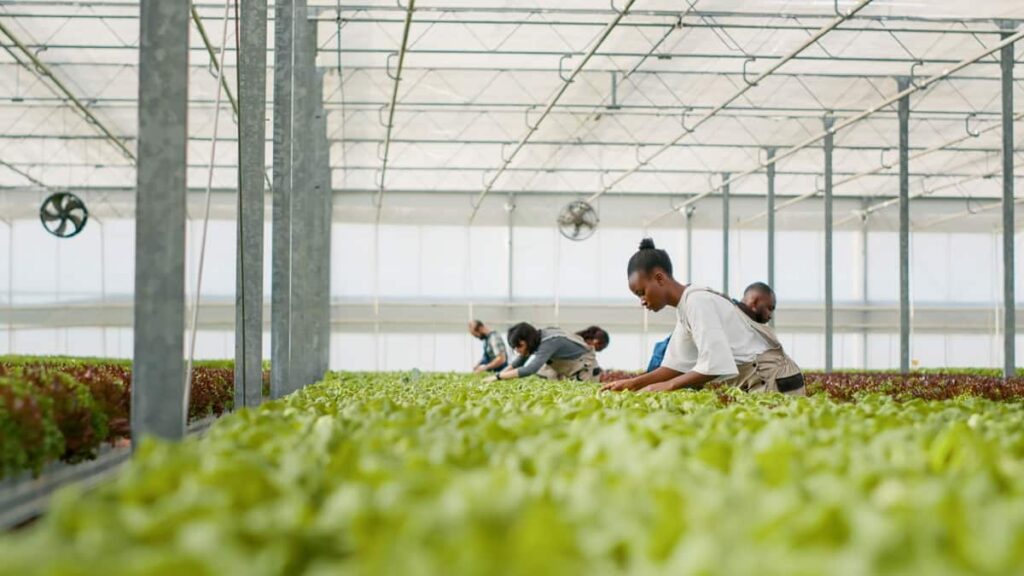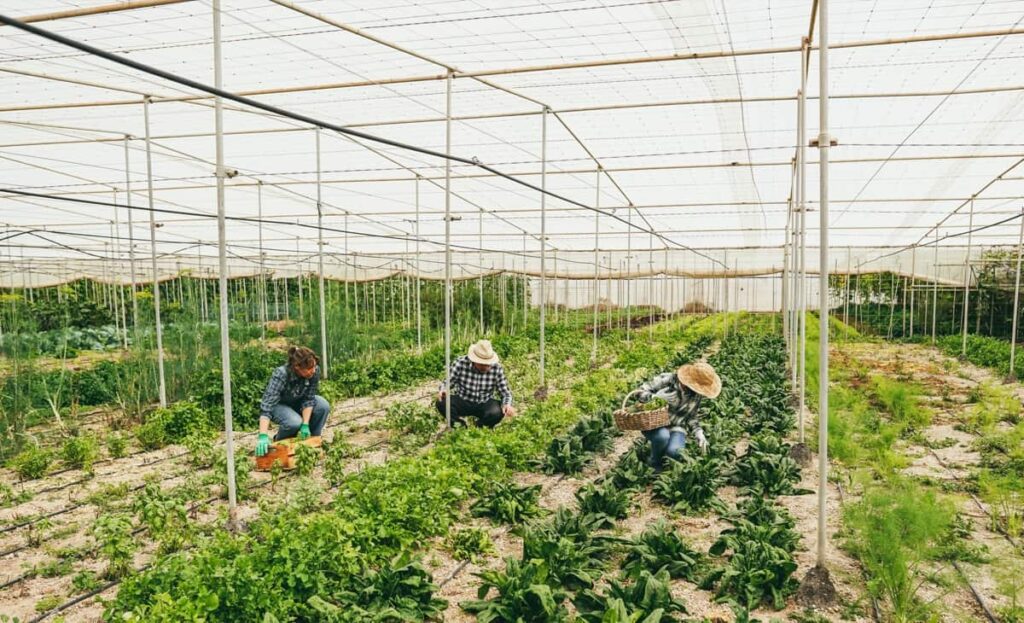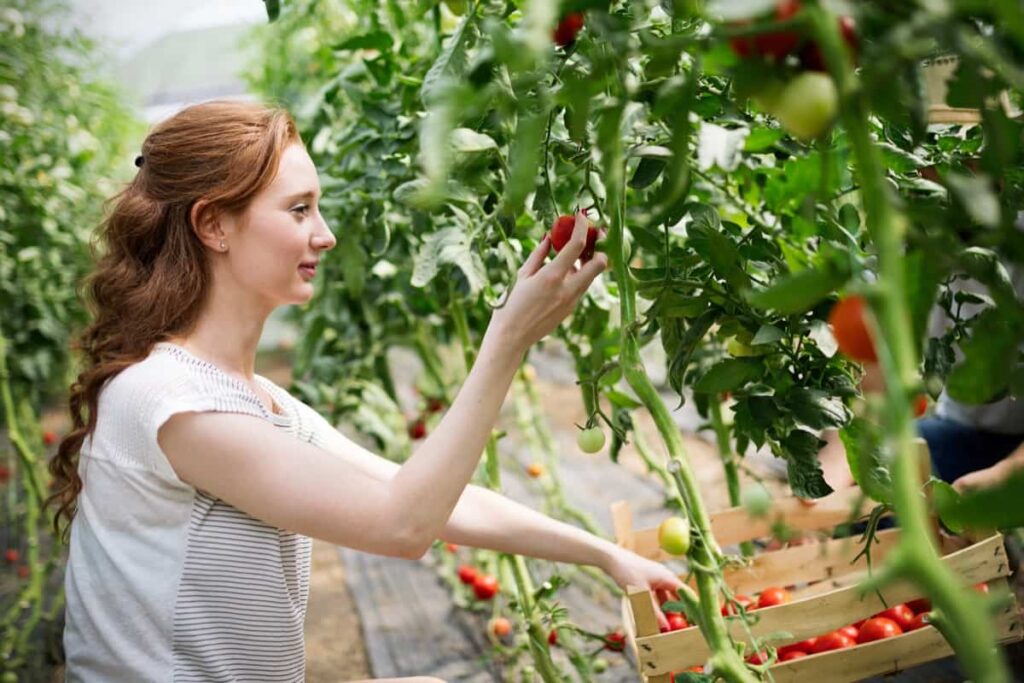Welcome to our comprehensive guide on greenhouse farming in Tanzania—a game-changing technique that enhances crop yields and boosts income for farmers. This blog will delve into modern agriculture, where enclosed and transparent structures create an ideal environment for crops, shielding them from extreme conditions.

With a focus on maximizing production and minimizing risks, greenhouse farming offers year-round cultivation, lower disease prevalence, and healthier, higher-yielding crops. Join us as we explore this innovative farming approach’s advantages and potential to transform Tanzania’s agricultural landscape.
What is Greenhouse Farming?
Greenhouse farming is a modern agricultural technique that cultivates crops in enclosed, transparent structures. These greenhouse allow farmers to control climatic conditions and sunlight, protecting the plants from extreme weather while ensuring a consistent and controlled environment for optimal growth.
General Information About Tanzania
Tanzania is located in East Africa and is bordered to the east by the Indian Ocean. It is comprised of the Tanganyika mainland and the Zanzibar Islands. Tanzania is considerably larger than the Netherlands, which has a total surface area of 41,528 square kilometers, with a total area of 945,087 square kilometers.
The population was estimated to be approximately 37,2 million in 2006, with 95% of the population being Bantu Africans. In 2002, Tanzania’s urbanization rate was approximately 30%, with Dar es Salaam, the region’s most populous city, home to 2.5 million people.
Advantages of Greenhouse Farming Systems
Year-round Production: Unlike traditional open-field agriculture, greenhouse agriculture is not reliant on rainfall. This characteristic makes it less susceptible to climate change and assures a year-round supply of crops. The enclosed environment of greenhouses reduces exposure to parasites and diseases, resulting in healthier plants and greater yields.
Higher Yields: The meticulously controlled conditions in greenhouses promote optimal growth, resulting in harvests that are more abundant and productive than open cultivation. Greenhouse farming requires less land to produce substantial yields, making it ideal for regions with limited space.
In case you missed it: How to Earn Excellent Income Returns with Commercial Vertical Farming

Lower Operating Costs: Although the initial investment in establishing a greenhouse may be greater, the lower water consumption and reduced need for pesticides and herbicides result in long-term cost savings.
Success Story: Mr. Benno Ndjovu’s Greenhouse Project: In Tanzania’s bustling city of Dar es Salaam, agricultural entrepreneur Mr. Benno Ndjovu invested in a greenhouse farming project, expecting impressive returns. With an area of 12m by 14m, his greenhouse produces an average of 10 crates of tomatoes per week, each valued at $16 in the market. These tomatoes boast a shelf-life of 21 days, surpassing the 14-day shelf-life of open-farmed tomatoes.
Expanding Greenhouse Farming in Tanzania
Tanzania’s small-scale farmers and agricultural entrepreneurs can embrace this technology to boost their productivity and profits. The Balton Group is one of the companies offering technical assistance and training programs to help farmers adopt greenhouse farming effectively. Tanzania’s horticulture sector holds immense potential, with diverse climates and geographical regions supporting the production of various fruits and vegetables.
Over the years, this sector has seen significant growth, aiming to achieve a remarkable $3 billion annual export, up from $779 million in 2019, as part of Tanzania Development Vision 2025. However, challenges like low-quality produce, inadequate packaging, poor traceability, unreliable transportation, and high postharvest losses hinder the sector’s productivity.
Addressing these issues, the Tanzania Horticultural Association (TAHA), a member-based trade association founded in 2004, has been at the forefront of promoting the growth and competitiveness of the horticulture sector. Representing around 42,000 farmers and collaborating with international agencies like USDA and USAID, TAHA strives to enhance agricultural practices and advocate for industry producers, exporters, and processors.
Tanzania’s Gross Domestic Product (GDP) 2005 amounted to Tsh 13,063,317 million (approximately € 7,936,879,500). Agriculture is vital to the country’s economy, contributing to around 50% of the GDP. Other significant sectors include trade and tourism, accounting for 17% of the GDP. Tanzania boasts abundant natural resources, such as gold, diamonds, natural gas, and iron ore, with mining and quarrying representing 3.5% of the GDP. Additionally, approximately 23% of Tanzania’s surface area is designated national parks, conservation areas, or game reserves.
Climate and Agriculture in Tanzania
Tanzania has a tropical climate, with temperatures consistently above 20°C in the coastal and between 10°C to 20°C in the highlands. The hottest period occurs from November to February. The country experiences two distinct rainfall regimes: a bimodal regime in the coastal zone and a unimodal regime in other areas. The bimodal regime has two rainy periods: Masika from March to June, Vuli from September to January, and the unimodal regime’s rainy season from November to May.
In case you missed it: Vertical Strawberry Farming: A New Way to Increase Your Income and Yield

Sowing or planting occurs just before each rainy season, and harvest follows immediately after. Due to the reliance on rainfall for agriculture, vegetable farmers in Tanzania typically plant just before the start of the rain periods in October or March. This results in peak vegetable production from July to September and generally lower prices during that period.
To mitigate this effect, introducing efficient and affordable irrigation systems could help farmers access water beyond the rain periods. Currently, only 3.8% of the total arable and horticultural cultivation land is irrigated in Tanzania, offering expansion and enhanced crop production potential.
Tanzania’s Horticulture Sector Boosting Crop Yield and Farming
Tanzania’s Growing Horticulture Sector: Tanzania ranks among the top 20 global vegetable producers, and its horticulture exports have seen impressive growth over the years. The sector’s annual growth rate of 11% surpasses the overall agricultural growth rate of 4%. More than 450,000 people find employment in this sector, mostly women. The country aims to increase its exports to $3 billion by 2025.
Vast Potential for Fruits and Vegetables: Tanzania’s favorable climate conditions and diverse geographical features enable it to grow various fruits, vegetables, herbs, and spices. The country’s stable economy, supportive political environment, and competitive labor costs provide a strong foundation for the horticulture industry’s growth.
Challenges in Food Loss and Waste: Like many regions globally, the horticulture sector in Tanzania faces significant food loss and waste (FLW) challenges. FLW occurs at various stages, including harvest, storage, handling, and distribution. With its fragmented value chains and inadequate temperature management, the distribution stage contributes to substantial food losses in Sub-Saharan Africa. In Tanzania, food loss is estimated at 40% for the domestic market but decreases to 10% in the export market due to improved postharvest practices and a streamlined value chain.
TAHA’s Holistic Approach to Reducing Food Loss: TAHA’s efforts to reduce food loss encompass various strategies. The association starts by building the capacity of farmers through agronomists present in 21 regions. Farmers are trained on production techniques and postharvest management practices to preserve the quality and quantity of their produce.
Market Access for Farmers: TAHA facilitates market linkages for farmers, connecting them to processors and exporters. It focuses on increasing investments in processing, which is crucial for preserving surplus produce. The Fresh to Market initiative, launched in 2018, is dedicated to improving postharvest issues in transportation and packaging. Through this initiative, TAHA has successfully connected farmers to global markets, enabling them to earn the GlobalG.A.P. certification.
Value Chain Infrastructure and Export Services: TAHA strategically places packhouses and collection centers at critical loss points in the value chain. The TAHAFresh initiative, established in 2008, serves as a premier logistics service provider, offering integrated services like airfreight, sea freight forwarding, trucking, and customs clearing, complete with cold rooms at various ports. However, the cold chain infrastructure still needs to be improved due to inadequate electricity supply and refrigerated trucks’ availability and affordability.
In case you missed it: Growing Green Futures: A Guide to Greenhouse Farming in Ethiopia

Types of Greenhouses in Tanzania
- Traditional Greenhouses are simple structures made of locally available materials like bamboo, wood, or polythene sheets. They are cost-effective but may lack advanced climate control features.
- Polyethylene Greenhouses: Utilizing polyethylene film covers, these greenhouses are affordable and easy to set up. They provide basic climate control and are suitable for small-scale farmers.
- Tunnel Greenhouses: Also known as hoop houses, these structures are rounded or arched. They offer good insulation and are ideal for crops that require protection from extreme weather.
- Glass Greenhouses: More expensive but highly durable, glass greenhouses provide excellent light transmission and create a controlled environment for delicate crops.
- Net Houses: These greenhouses use nets instead of solid covers, protecting from pests and harsh weather while allowing better air circulation.
Greenhouse Farming Techniques in Tanzania
Tanzanian greenhouse farming employs innovative practices to optimize crop cultivation within controlled environments, enhancing productivity and mitigating environmental challenges. These techniques include crop rotation, integrated pest management (IPM), drip irrigation, hydroponics and aquaponics, climate control automation, vertical farming, smart monitoring systems, and cover crops. IPM minimizes reliance on harmful pesticides, while drip irrigation conserves water and prevents evaporation.
Hydroponics and aquaponics combine with fish cultivation, creating a symbiotic relationship between plants and aquatic organisms. Climate control automation optimizes growth conditions, while vertical farming maximizes land use efficiency in urban areas. Smart monitoring systems provide data-driven insights for informed water, nutrients, and climate management decisions.
Sustainable Practices in Tanzania: Greenhouse Farming
Tanzania Greenhouse Farming prioritizes sustainability to ensure long-term viability. Key practices include water recycling, renewable energy integration, organic farming, cover cropping, and biodiversity promotion.
In case you missed it: Revolutionizing Agriculture: Exploring Morroco Greenhouse Farming

Water recycling and reusing water conserve resources, while renewable energy sources reduce carbon footprints. Organic farming avoids synthetic chemicals, while cover cropping improves soil fertility and prevents erosion. Encouraging biodiversity through native species and beneficial insect habitats contributes to ecosystem balance.
Climate Control Systems for Tanzanian Greenhouses
Tanzania’s greenhouses require effective climate control systems to maintain optimal conditions for crop growth. Popular systems include ventilation, shade nets, cooling pads and fans, heating systems, and automated climate control. Proper ventilation regulates temperature, humidity, and CO2 levels, while shade nets prevent heat buildup. Heating systems, such as gas heaters or geothermal heating, maintain warmth during colder months. Advanced systems use sensors and computer technology to automate climate control processes.
Pest and Disease Management in Tanzania Greenhouse Farms
Effective pest and disease management is crucial for healthy, high-yielding crops in Tanzania’s greenhouse farms. Integrated Pest Management (IPM) practices are employed to minimize chemical pesticide use and promote environmentally friendly solutions.
Farmers in Tanzania use biological control, cultural practices, and resistant crop varieties to control pest populations. Biological control involves natural predators and beneficial organisms, while cultural practices like proper sanitation and crop rotation reduce pest and disease pressure. Selecting resistant crop varieties enhances crop resilience.
Greenhouse Automation Technologies in Tanzania
Greenhouse automation technologies are increasingly popular in Tanzania to enhance crop production efficiency and optimize resource utilization. These technologies include climate control, irrigation, and monitoring systems. Automated climate control systems regulate temperature, humidity, and ventilation, creating an ideal environment for crop growth.
Automated irrigation systems, like drip irrigation and hydroponics, provide accurate water delivery while conserving water resources. Monitoring and control systems with sensors and data analytics enable farmers to closely monitor plant health, environmental conditions, and nutrient levels, enabling timely adjustments and decision-making to optimize crop performance.
Energy-efficient Practices in Tanzania Greenhouse Farming
Tanzania’s greenhouse farming requires adopting energy-efficient practices, such as using solar panels, LED lights for customized lighting, insulating the greenhouse, heat recovery systems, and smart energy management to optimize energy usage based on real-time data. These practices contribute to sustainable greenhouse farming practices in Tanzania.
Market Trends and Opportunities in Zambian Greenhouse Farming
- Export Growth: High-quality greenhouse produce has significant potential in international markets.
- Organic Produce Demand: Consumers’ increasing preference for organic produce presents an opportunity for organic greenhouse farming.
- Vertical Farming: Utilizing vertical space can maximize productivity and address land constraints.
- Technology Integration: Smart greenhouse technologies and precision farming are gaining traction.
Tanzanian Farmer’s Success in Greenhouse Farming
Tanzanian farmer Benno Ndjovu has showcased the potential of greenhouse farming by constructing a plastic greenhouse in Dar es Salaam. With an initial investment of US$4,458, the greenhouse utilizes a drip water irrigation system and is expected to produce tomatoes worth US$12,738 per week after six months. According to Ndjovu, greenhouse farming’s advantages include year-round production independent of rain and lower disease risks than open farming.
In case you missed it: How to Maximize Profit in Greenhouse Farming: Take an Advantage of Future Farming

The greenhouse, occupying an area of 12m by 42m, has yielded an average of 10 crates of tomatoes per week, fetching US$16 in the market. Ndjovu plans to expand his greenhouse farming to five hectares in Dar es Salaam, aiming to supply 2,000 crates of fresh tomatoes weekly. The success of greenhouse farming, with higher yields and longer, shelf-life for the produce, proves to be a profitable venture requiring less capital and time than other farming practices like poultry keeping.
Conclusion
Greenhouse agriculture in Tanzania is a promising strategy for increasing crop yields and income. With controlled environments, efficient irrigation, and insect management, producers can achieve year-round production, higher quality produce, and increased profitability, thereby contributing to the expansion and competitiveness of the nation’s horticulture sector.
- Broccoli Varieties: Choosing the Right Cultivars for Your Farm
- How to Raise Pigs in Your Own Backyard: A Comprehensive Guide
- Budget Friendly Sheep Shed Ideas: Cheap and Low-Cost Tips
- How Much Do Cattle Farmers Make: Revenue Streams in Cattle Farming
- Management Pests and Diseases in Your Cotton Field
- Sheep Farming Business Plan for Beginners
- Aquaponic Farming at Home: A Step-By-Step Guide
- Profitable Village Farming Business Ideas in 2024
- High-Yield Aquaculture: Fast-Growing Fish for Farming
- Effective Fish Pond Construction Techniques for Beginners
- Irrigation and Water Management in Pineapple Farming
- Blossom to Harvest: Mastering Flowering and Pollination in Papaya Farming
- Pig Fattening Essentials: From Selection to Sale for Beginners
- Raising Wagyu Cattle: A Complete Guide for Premium Beef Production
- Soil Types and Their Water Holding Capacity
- Optimizing Irrigation Schedules for Coconut Groves for Enhanced Yield
- Espresso Your Garden: Coffee Grounds for Healthier Acid-Loving Plants
- The Best Soil Mix for Snake Plants: How to Mix Your Own Snake Plant Soil
- Green Thumb Success: Expert Tips for Cultivating Greenhouse Beans All Year Round
- Bloom All Year Round: The Ultimate Guide to Indoor Hyacinth Care
- Eco-Friendly Gardening: How to Make Liquid Fertilizer from Kitchen Waste
- Ultimate Guide to Grow Anise in Pots: Explore Seed Propagation to Harvesting
- Guide to Raising Chester White Pigs: Discover Breed Facts to Growth Management
- Mastering the Elegance: The Ultimate Guide to Weeping Cherry Tree Care, Planting, and Maintenance
- Ultimate Guide to Planting Garlic in Grow Bags: Growing Strategies for Beginners
- How to Fix Spider Plant Leaf-Related Problems: Natural and Organic Remedies
- 10 Reasons Why Your Tulsi Plant is Shedding Leaves: Home Remedies and Solutions
- Optimizing Growth and Yield: The Advantages of Palm Bunch Ash Fertilizer
- Utilizing Neem Oil Extract as a Natural Pesticide for Hydrangea
- From Soil to Harvest: Various Ways in Which Farmers Can Use AI Tools
- Steps to Encourage and Induce Citrus Flowers: A Comprehensive Guide
- How to Fix Snake Plant Leaf-Related Issues: Natural and Organic Remedies
- Transform Your Garden into a Fragrant Oasis with Raat Ki Rani (Night Blooming Jasmine)
- Discover the Ideal Chicken Breeds for Philippine Farms
- How to Create a Poultry Egg Farm Business Plan for Profits
- Grow Lemon Cucumbers Like a Pro: Insider Techniques for Bountiful Yields
